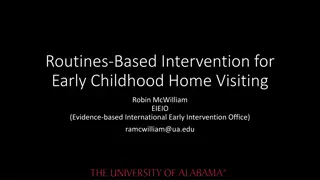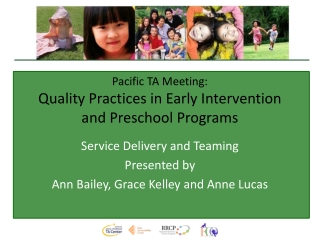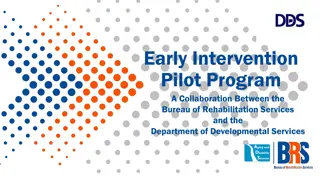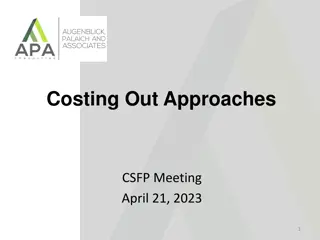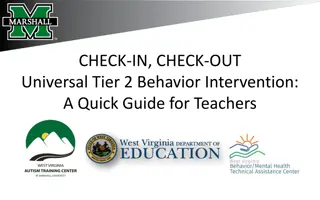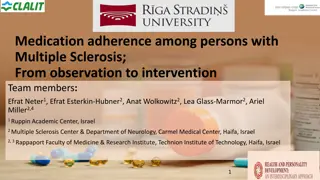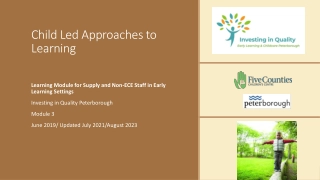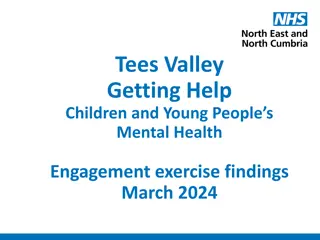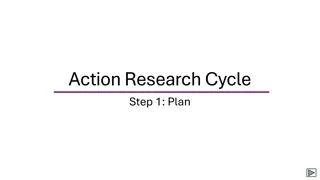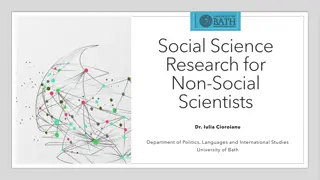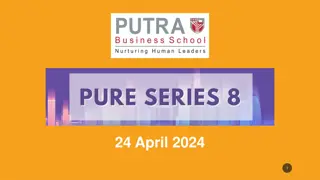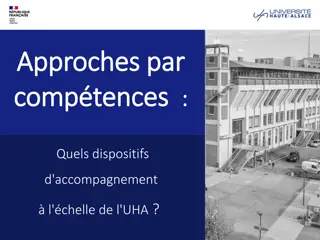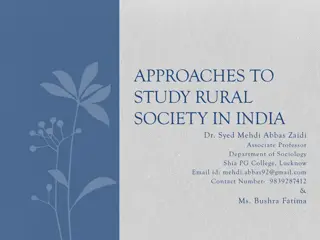Early Intervention Approaches and Research Findings
Explore various approaches and techniques for early intervention, focusing on settings, delivery models, stimulation methods, and caregiver involvement. Discover recent studies on infants born during the pandemic and preterm children's outcomes, emphasizing the importance of language, motor, and cognitive development. Recommendations include enhancing mother-child interactions for better language outcomes.
Download Presentation
Please find below an Image/Link to download the presentation.
The content on the website is provided AS IS for your information and personal use only. It may not be sold, licensed, or shared on other websites without obtaining consent from the author. Download presentation by click this link. If you encounter any issues during the download, it is possible that the publisher has removed the file from their server.
Presentation Transcript
Approaches and Techniques for Early Intervention
PowerPoint Outline I. Settings and Delivery Models II. Focused Stimulation III. Parallel and Self Talk IV. Extensions V. Mand-model VI. Recasting VII. Additional Techniques for Caregivers (Hanen, Jeannette Reiff) VIII. Helping Young Children Learn to Join Groups IX. Facilitating Early Literacy Skills
Nature News 2022:** https://www.nature.com/articles/d41586-022-00027-4 Infants born during pandemic scored lower on tests of gross motor, fine motor and communication skills compared with those born before it Speech, language, cognitive skills are substantially delayed
Before we dive in, just a word about preterm infants:** Loeb et al. (2020). Language, motor, and cognitive outcomes of toddlers who were born preterm. American Journal of Speech-Language Pathology, 29, 625-637.
Loeb et al. 2020:** When young preterm children display language delays, test for presence of cognitive and/or motor delays
Younesian et al. (2021). Maternal interactive beliefs and style as predictors of language development in preterm and full term children. Journal of Child Language, 48(2), pp. 214-243.** They studied differences between mothers of pre- term and full-term children in terms of interactive beliefs and style They asked: do these beliefs and styles predict potential for the children s language development?
Younesian et al. recommended: Improve mother-ch interactions esp. with moms of pre- term ch
Spicer-Cain et al. 2023the most important things to look for in assessment of very young children:
I. Settings and Delivery Models** SLP just consults with caregivers (parents, day care workers, preschool teachers) Work directly in the classroom or day care setting (me going into Head Start classroom at my school) Home visits direct tx in home The child can come to the SLP s room for group or 1:1
Vroom:** (not on exam) A wonderful app that has lots of suggestions for language stimulation Highly recommended!
Focused stimulation is:** Concentrated repetitions of specific linguistic forms in natural communication contexts
Focused stimulation is especially good for:** Late-talking toddlers Children with DLD and intellectual disability Bilingual children in silent period
There are 2 ways to use focused stimulation:** 1. Repeatedly model target structure and don t elicit responses from children 2. Elicit responses and add extensions
https://www.youtube.com/watch ?v=kRxHHrTXQcs Speech and language therapy strategy: Expanding language Youtube video
Though helpful, focused stimulation is not enough* Eidsvag, S., Plante, E., Oglivic, T., Privette, C., & Mailend, M-L.. Individual vs. small group treatment of morphological errors for children with developmental language disorder. Language, Speech, and Hearing Services in Schools. Studied N=20 preschool children Looked at learning of a new morpheme Compared just modeling to direct expressive practice
III. Parallel and Self Talk** Parallel talk: the SLP plays with the child and comments on what the child is doing Self talk: SLP describes what they are doing
IV. Extension** The SLP adds new information to the child s utterance Extend these utterances: Me pet kitty. Doggy bark. Want cereal. Swim!
V. Mand-Model** The SLP says Tell me what you want. Child: Ball SLP: Say I want the ball. Child: I want the ball.
VI. Recasting** The SLP repeats the child s sentence but changes the modality or voice of the sentence Child: I m hungry. SLP: You are feeling hungry? Child: Doggy chased kitty. SLP: Yes, the kitty was chased by the doggy.
VII. Specific Techniques for Caregivers to Facilitate Interaction** Being responsive to the child is the key Respond promptly (often within 1-2 seconds of a child doing or saying something) Respond positively show genuine interest
Hanen** Stick with what the child is talking about and don t try to get him interested in something else (e.g., if the child is showing the parent how he can drive his toy car along the kitchen floor, the parent then talks about what he is doing with the car, not the color of the car or about the toy train)
Marklund et al. (2015). Pause and utterance duration Journal of Child Language, 42, 1158- 1171.** Study carried out in Sweden with parents and 1;6 year olds Found: children whose parents responded the fastest to their utterances had the largest vocabularies Children of slow responding parents had smaller vocabularies
ASHA Leader: Conversational turns linked to better language development in children.** Language Environment Analysis (LENA) devices recorded every word spoken by parents of young children for several days Increased conversational turns correlated with better scores on test of language skills
Guiberson et al. Language experience in the second year of life and language outcomes in late childhood. Pediatrics, 142(4), 1-11.** Studied 146 infants and toddlers for 6 months Examined home turntaking interactions between children and caregivers Followed up when Ss were 9-14 years old (language and cognitive testing)
Guiberson et al. continued:** Talk and interaction between children and caregivers between 18-24 mos. of age especially predicted school-age language and cognitive outcomes 18-24 months of age is a very critical window
A major red flag for early language impairment:
When we dont see imitation in children, we suspect suspect other delays too:** Social Sensory Processing Cognition Motor Verbal Key purpose for Assessment: Identify if this is an expressive delay only or are there other developmental issues
If child is not imitating Sensory Processing Disorder?** May not be talking because sensory processing system is out of sync Theory of internal noise May cause the child to block everything else out Intrinsically disorganized Struggling with self-regulation and calming
If child is not imitating cognitive issue?** Child may not be at the 9-12 month cognitive level yet Not developmentally ready to talk! A foundation for language Remember Piaget s cognitive theory: the first word appears around the time a child has symbolic play and object permanence That s why it s so important to test those cognitive skills
If a child is over 12 months of age and is not imitating . . .** This is clinically significant If you re not working on the right goals, you won t see any progress This is true especially if there are multiple underlying reasons why the child isn t talking
Our treatment plans may have to include more than just expressive language goals** Building verbal imitation is expressive language But make sure the child is ready for this Many therapists jump right into imitation at the single word level--this may not promote early success Parents are going to feel better about you and your skills if you can demonstrate progress early; remember to under promise and over deliver
Building Imitation Through Play** Motor Imitation Imitating actions with objects Developmentally appropriate No demands on the child s linguistic system Child learns to repeat an action that he sees another person perform with an object Prerequisites for motor imitation through play: Motor and social proficiency at 6-9 month developmental level
Imitating Actions in Play** Begin with expected actions with objects: Blocks Toy vehicles Musical instruments Plastic dishes and utensils Pretend food Toys with tools
Teach parents to use everyday objects in daily routines by having the child do things like . . .
Tip . . .** Research confirms that a toddler s attention span is variable Usually children s attention span in minutes corresponds with their chronological age Thus, a 3-year old will have a 3-minute attention span This may vary with individual children Have a huge variety of engaging toys and activities!
Trouble shooting if they still wont imitate actions . . .** Be more fun!! Make the target easier Avoid power struggles Consider sensory needs Sing as you model actions. I roll the ball to you. You roll the ball to me. If a child is too busy, get him regulated and calmer first, then present toys
Imitating Communicative Gestures** Child imitates actions that convey meaning to another person Early gestures to try: Waving and pointing Clapping High Five Knocking on the door Sign language/Baby signs
Good choice first signs . . .** more and please and want to initiate requesting Eat Milk All done Go Open Mine Cookie, bubbles, baby, car, play, mommy, daddy
https://www.youtube.com/watch ?v=7ZERrCnMNtM Tips for teaching your child how to copy and learn from others
IX. FACILITATING EARLY LITERACY SKILLS** New research discusses ideal ways to interact with children during storybook reading O Fallon et al. (2020) Preschoolers word-learning during storybook reading interactions: Comparing repeated and elaborated input. Journal of Language, Speech, and Hearing Research, 63(3), 814-826.
OFallon et al. 2020 found that:** Typically-developing preschoolers demonstrated successful receptive word learning of new words after a single storybook reading interaction with an adult when target words were repeated Saying new words once--not as effective as repeating them



